For motorsports enthusiasts of all forms, perhaps the greatest “Mecca” is the Goodwood Festival of Speed. Held since 1993, the event brings together stars from all disciplines, both active and past heroes. In 2016, for example, drivers such as René Arnoux, Jenson Button, Emerson Fittipaldi, Jochen Mass, Stirling Moss, Riccardo Patrese, John Surtees, Mark Webber, and Derek Bell were present. More than that, event attendees have the opportunity to see machines from all eras and disciplines of motorsports, such as Group C, F1, WRC, WEC, IndyCar, NASCAR, Pikes Peak, and Group B cars, as well as dream machines like the Bugatti Chiron, McLaren P1, and LaFerrari. One of the highlights is the hillclimb competition, held on a 1.16-mile track built specifically for the event. We originally planned to present here the 20 fastest times officially recorded at the event up to 2016, but since then the times have steadily dropped, and our current count is now at 38! This takes into account that in the case of drivers who have participated in more than one edition with the same car, only the best time will be counted. [This post was last updated on 07/09/2025].
38. Olivier Hancock – LEC CRP1 Cosworth (2015) – 47s26
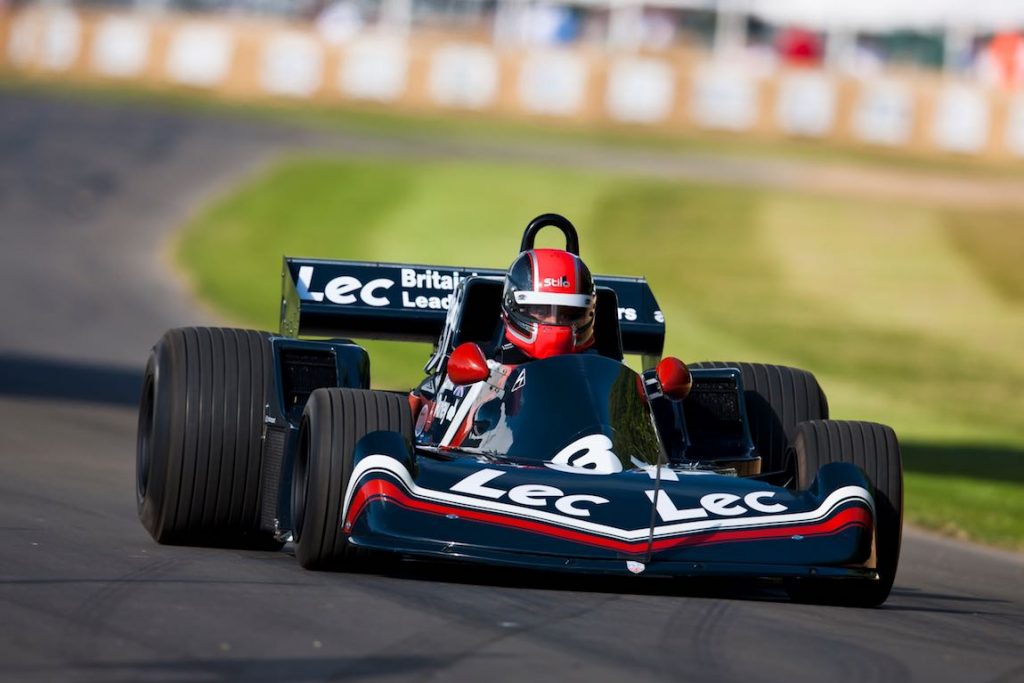
Developed for the 1977 season, the CRP1 was the only car genuinely designed by LEC Refrigeration, a team sponsored by the eponymous refrigeration systems company. Designed by Mike Pilbeam and driven by Mike Earle and David Purley, it competed in five races of the 1977 world championship without scoring points. Its most memorable moment was the accident at the British Grand Prix at Silverstone, where Purley hit a wall and suffered what was considered for years the greatest deceleration a human being has survived, with an estimated 179.8 g of deceleration. Both cars have been restored and now compete in historic competitions. In 2015, Olivier Hancock clocked a time of 47.26 seconds and finished seventh in the shootout.
37. James Littlejohn – LEC CRP1 Cosworth (2015) – 47s19
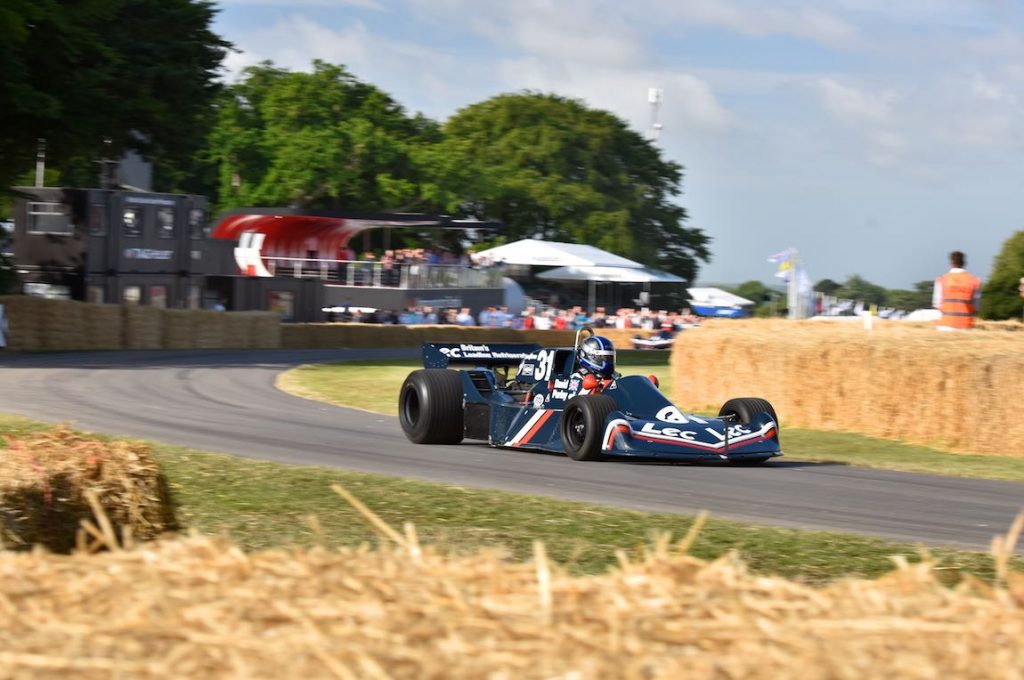
Driving the other LEC CRP1, Englishman James Littlejohn managed to be 7 hundredths faster than Olivier Hancock and took 6th place in the 2015 shootout.
36. Michel Lyons – Hesketh 308E Cosworth (2015) – 47s17
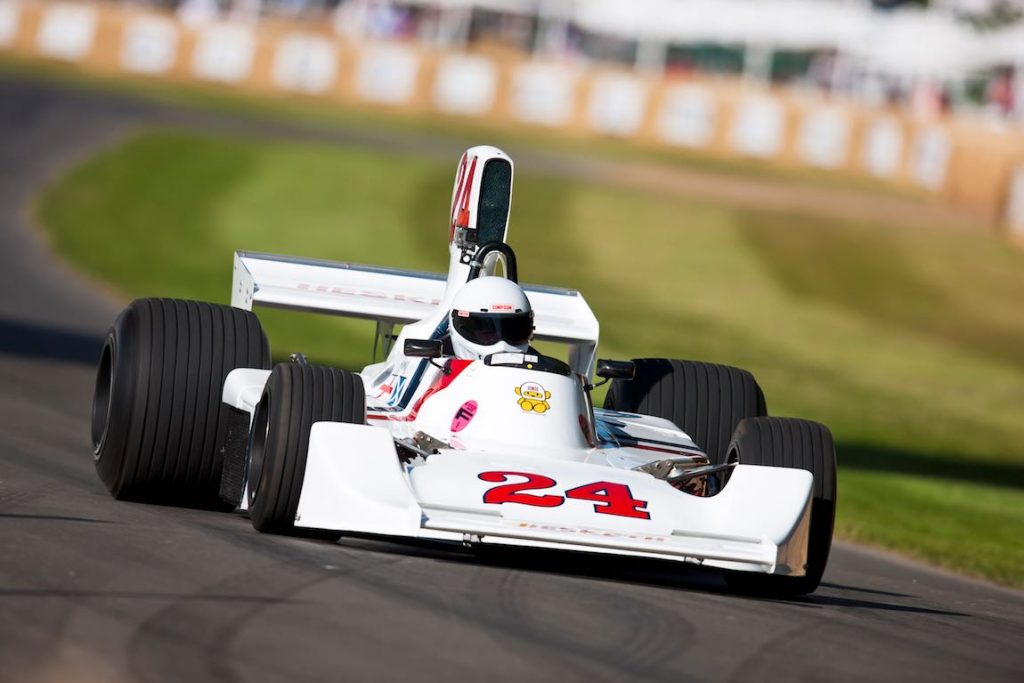
Also from 1977, the 308E was the last car created by Hesketh before its bankruptcy in 1978. The model struggled to pass pre-qualifying during the 1977 and 78 seasons, withdrawing from the F1 world championship without scoring any points. Designed by Frank Dernie and Nigel Stroud, the 308E was a very conventional design, with an aluminum monocoque, a Cosworth DFV engine, and a Hewland transmission. The car became known for boasting sponsorship from the men’s magazine Penthouse, and also participated in several races in the British Formula 1 championship, where it achieved average results. Lyons’ time in 2015 placed him in 5th place in the shootout, just 2 hundredths of a second ahead of James Littlejohn’s LEC CRP1.
35. Jeremy Smith – Spice SE88 Cosworth (2021) – 47s16
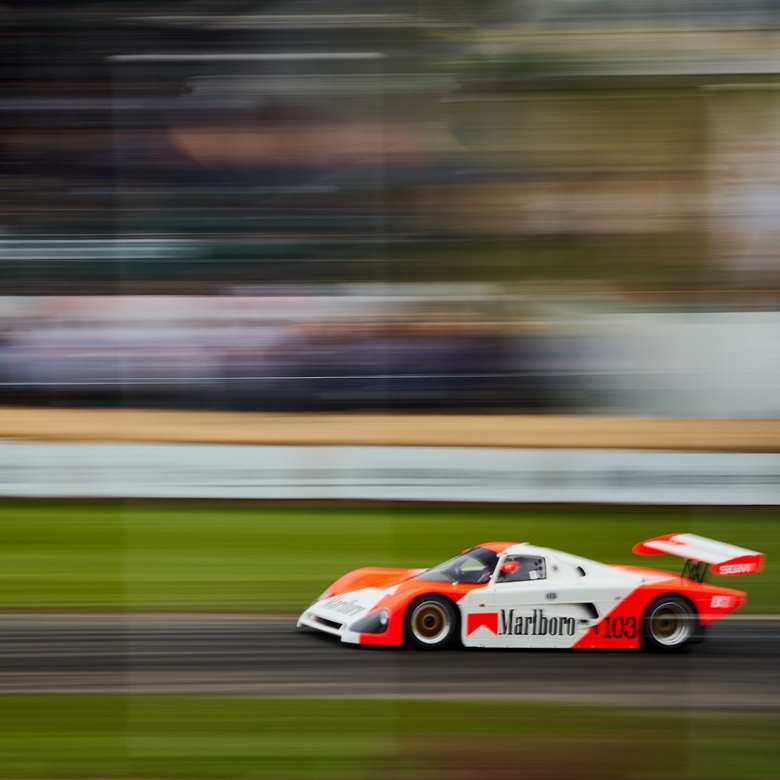
Developed for the 1988 season, the SE88 was an evolution of the 1987 car and was eligible for competition in both Europe and the United States, competing under Group C and C2 regulations, as well as IMSA GTP and GTP Lights, depending on the engine chosen. Equipped with a Cosworth engine and driven by Ray Bellm and Gordon Spice himself, the SE88 dominated the World Championship for Makes, winning 11 of the 12 races in its class, including the 24 Hours of Le Mans. In 2021, Jeremy Smith had a strong race, finishing third overall.
34. Roger Wills – Williams FW05 Cosworth (2010) – 47s15
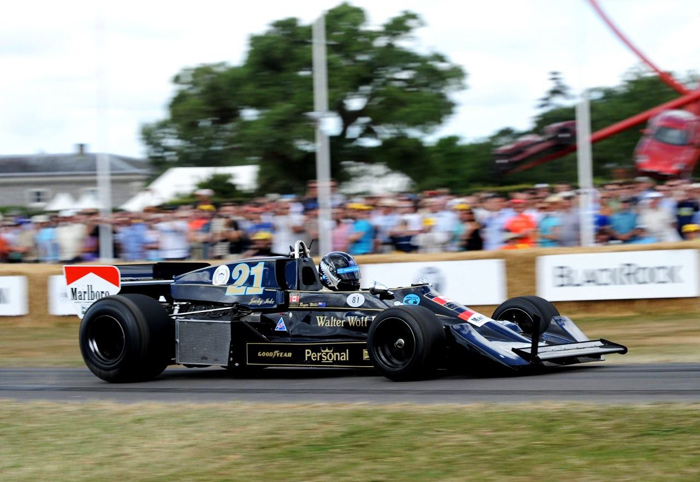
The second car built by Frank Williams’s squad, the FW05 was developed for the 1976 season using as a base a 1975 Hesketh 308C purchased for £450,000, which was redesigned by Englishman Harvey Postlethwaite. Equipped with the standard powertrain of the time (Cosworth DFV engine + Hewland DG400 transmission), the car was driven by several drivers, including Jacky Ickx and Arturo Merzario, but failed to score points during the season. In 2010 Roger Wills drove it impeccably around the 1.16-mile track at Goodwood to win the shootout.
33. Kenny Brack – McLaren P1 LM (2016) – 47s07
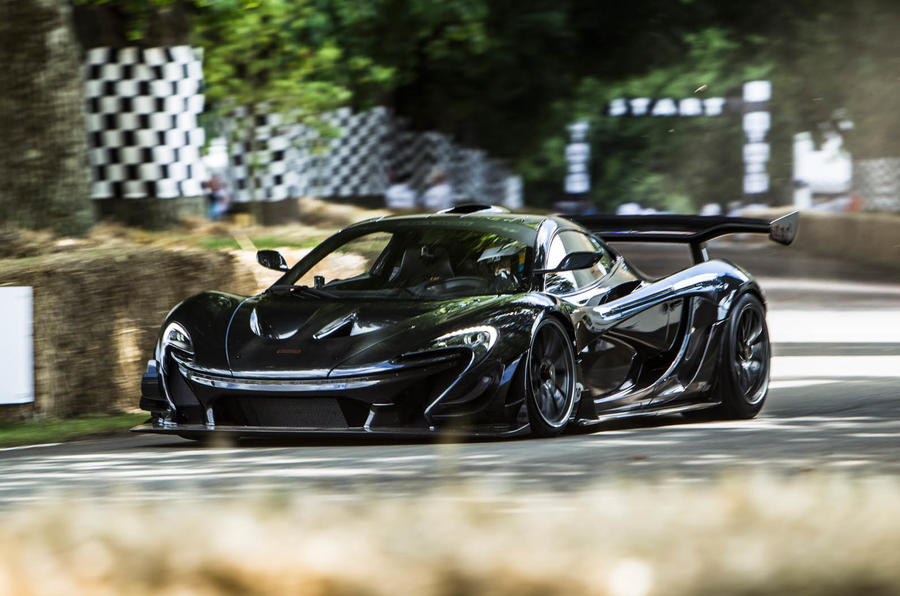
Created in 2015 to celebrate the 20th anniversary of the McLaren F1 victory at Le Mans, the McLaren P1 GTR was originally intended for the track. Some owners, wanting to use their cars on the street as well, approached the English company Lanzante Motorsports to convert their P1 GTRs into street cars. Seeing this trend, McLaren decided to produce five new cars called P1 LM, following the specifications of the cars converted by Lanzante. Entered with hopes of winning the shootout, Swede Kenny Brack took the P1 LM around the Goodwood track in a time of 47.07 seconds, and despite finishing second, secured what would become the track record for a street car at the time.
32. Jeremy Smith – March 2-4-0 Cosworth (2015) – 47s05
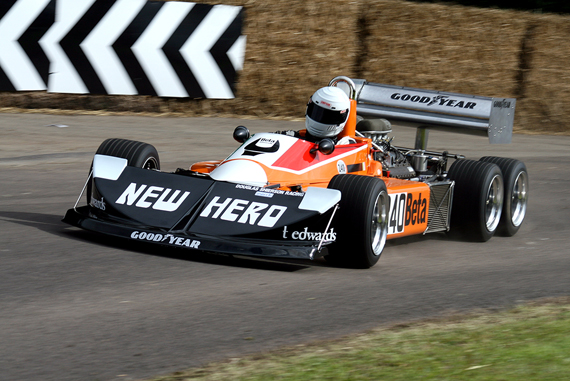
Following the relative success of the Tyrrell P34 in the 1976 season, March Engineering designer Robin Herd began to toy with the idea of six-wheeled cars. After analyzing the P34’s design and concluding that the large rear wheels should still account for about 40% of the total aerodynamic drag, he created the 2-4-0 concept, which used four smaller wheels similar to the front ones at the rear to maintain traction. The car was built using a March 761 as a base in 1976 and tested throughout 1977, but the need for greater investment in a more robust transmission led March to cancel the program. In 1979, English hillclimb driver Roy Lane revived the concept using a March 771 and the March-developed transmission, but eventually reverted to conventional four-wheel drive after encountering reliability issues. In 2015, Jeremy Smith drove March 2-4-0 in the shootout and secured fourth place in the standings.
31. Michael Lyons – McLaren M26 Cosworth (2023) – 46s89

The McLaren M26 was designed by Gordon Coppuck to replace the M23, debuting at the 1976 Dutch Grand Prix, but failing to replicate the success of its predecessor, achieving only three victories. Eventually, an M26 chassis was redesigned to house a Chevrolet V8 engine, transforming it into a Formula 5000 car, used by Alfredo Costanzo to win the Australian Drivers’ Championship. In the 2023 shootout, Michael Lyons finished third with a time of 46.89 seconds.
30. Romain Dumas – Ford Pro Transit Electric SuperVan (2022) – 46s58
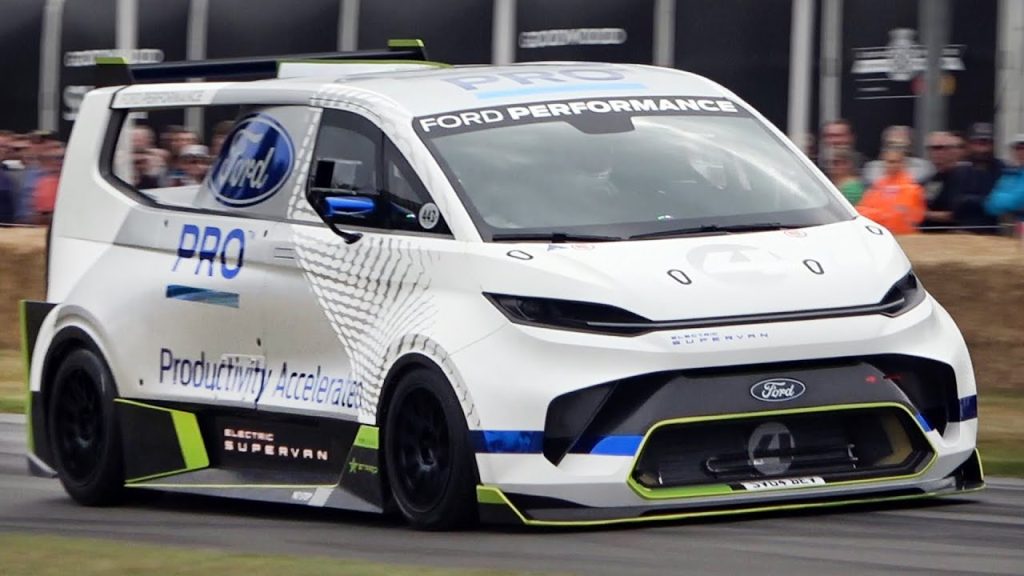
Romain Dumas also attended the 2022 shootout to defend his unofficial Goodwood record aboard the Ford Pro Electric SuperVan, the fourth-generation Ford Transit Supervan developed in conjunction with Austrian company STARD. Equipped with four electric motors (one for each wheel) totaling 1,972 hp, it features a 50 kWh liquid-cooled battery.
29. Anthony Reid – Chevron GT3 (2012) – 46s46
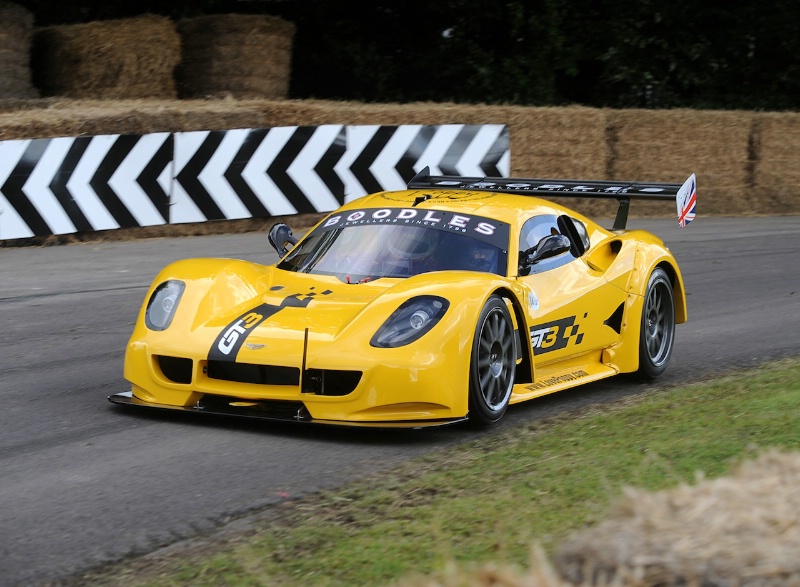
In 2010, Chevron introduced its first racing car since the 1960s, the GR8. Based on the B8 GT street sports car, it was equipped with a Cosworth 2.0-liter engine and was produced until 2011. In 2012, the GT3 model was introduced, based on the GR8 chassis but equipped with a 420-horsepower 3.5-liter engine. Designed with the GT3 regulations of the time in mind, the car has been used in various competitions, such as the British GT Championship. In the year of its introduction, Chevron entered the car in several hillclimb events to promote the new model. In the hands of Anthony Reid, the factory’s official driver, the GT3 clocked a time of 46.46 seconds in the 2012 shootout and secured a thrilling victory against opponents using Group C and Formula 1 cars.
28. Jörg Weidinger – BMW E36 Judd V8 (2018) – 46s43
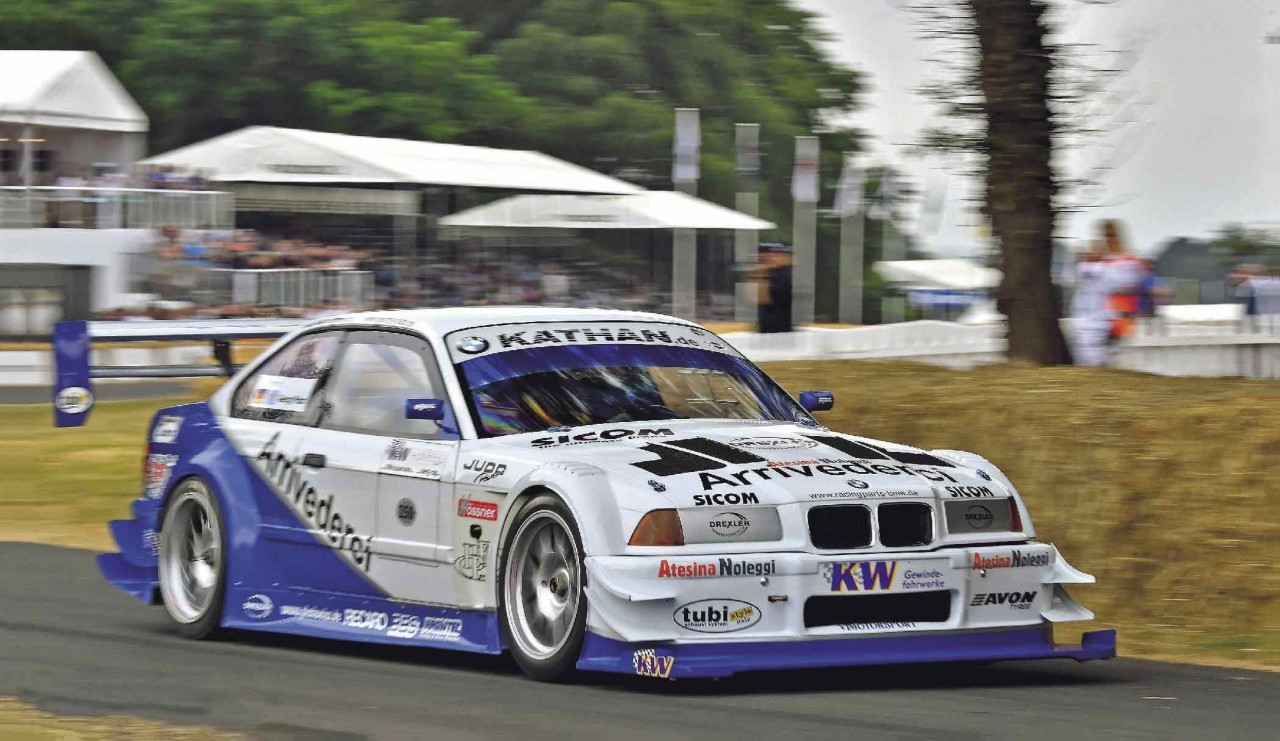
The BMW E36 pictured began life as a modest 1990 320i, with which German driver Georg Plasa began racing in 1999. Initially, the car was fitted with a four-cylinder S14 engine from an E30 M3, tuned to produce around 400 hp. Due to its high power output, the engine often operated well above its limit, requiring extensive maintenance after each event. In 2003, Plasa solved the problem by purchasing and installing a Judd KV675 V8 engine, the same engine that powered LMP2 cars at the time, in the BMW. Except for the original monocoque, every possible part was either removed or rebuilt in carbon fiber, resulting in a 895 kg, 560 hp car. With this model, Georg won the European Hill Climb Championship six times. After the death of driver Bruno Carotti in the 2011 Cuppa while driving another car, the E36 was acquired by Klaus Wohlfarth, founder of KW Suspensions, and has since been restored to its original condition. In 2018, Jörg Weidinger achieved a time of 46.43 seconds, placing third overall and the best internal combustion engine car of the year.
27. Jeremy Smith – Penske PC22 Chevrolet (2017) – 46s22
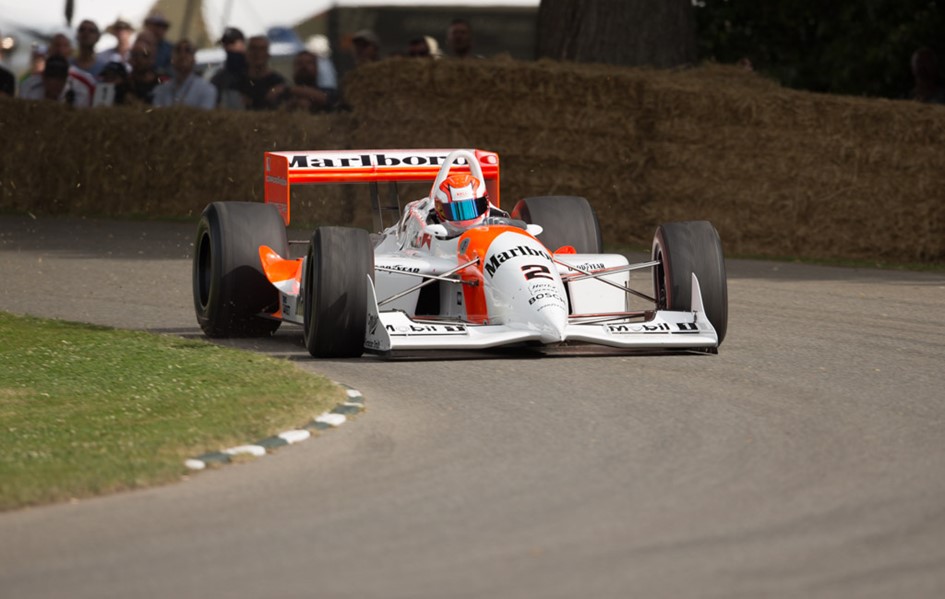
O Penske PC22 foi projetado por Nigel Bennett para a temporada The Penske PC22 was designed by Nigel Bennett for the 1993 IndyCar season, where it was driven by Emerson Fittipaldi and Paul Tracy. During the year, Penske achieved eight victories, including the Indianapolis 500 for Fittipaldi, and also second and third place in the drivers’ championship for Fittipaldi and Tracy, respectively. In the 2017 shootout, Jeremy Smith lost the victory by just 9 hundredths of a second to veteran Justin Law.1993 da Fórmula Indy, onde foi pilotado por Emerson Fittipaldi e Paul Tracy. Durante o ano a Penske obteve 8 vitórias, incluindo as 500 Milhas de Indianápolis pelas mãos de Fittipaldi, e também o segundo e terceiro lugares no campeonato de pilotos para Fittipaldi e Tracy, respectivamente. No shootout de 2017, Jeremy Smith perdeu a vitória por apenas 9 centésimos de segundo para o veterano Justin Law.
26. Travis Pastrana – Subaru GL Family Huckster (2022) – 46s20
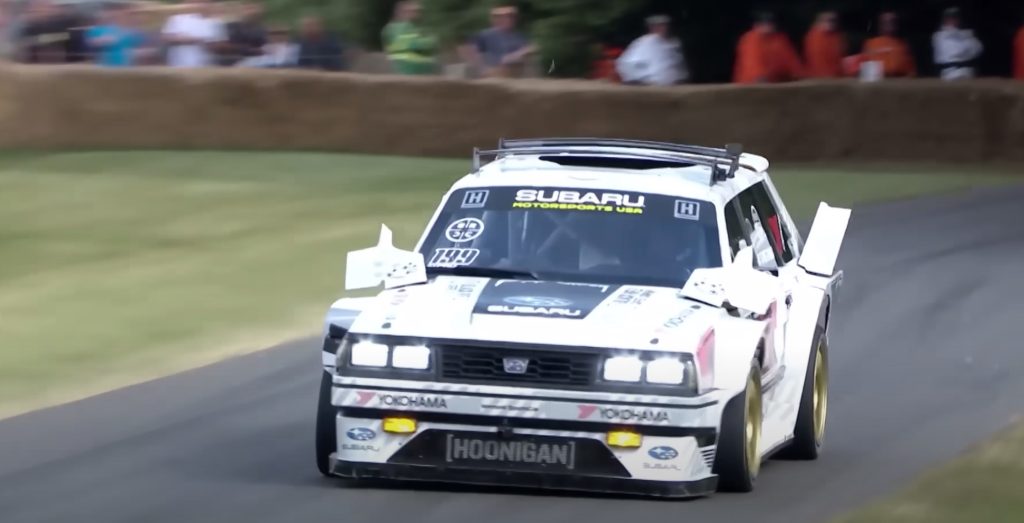
Another highlight of the 2022 shootout was Travis Pastrana’s participation at the wheel of a Subaru GL Family Huckster, a modest family car from the 1980s transformed into an 862-horsepower, active-aerodynamics monster. Pastrana, a professional auto racing and motocross driver, is already known for his daring stunts and maneuvers, and he did not disappoint at the Goodwood Shootout, posting a time of 46.20 seconds, which was only good enough for fifth place. In 2023, Pastrana returned to Goodwood again, taking second place with a time of 46.37 seconds.
25. Travis Pastrana – Subaru WRX STi Gymkhana (2021) – 46s20
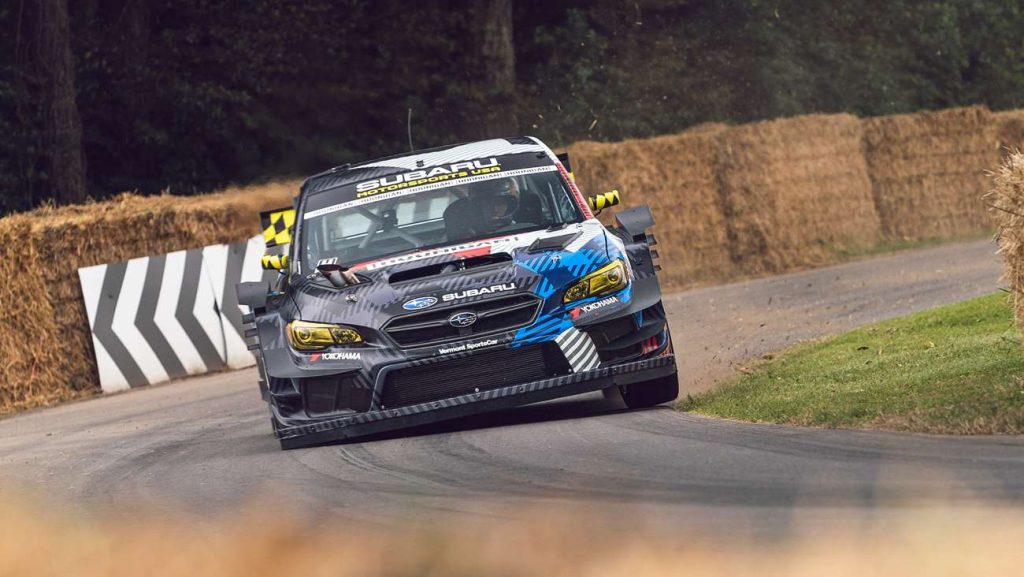
One of the most impressive participants in the 2021 Shootout, Travis Pastrana brought his Subaru WRX to prove that the car was capable of more than just beautiful video displays. Developed for the eleventh edition of the Gymkhana and equipped with an 826-hp billet boxer engine and an aerodynamic kit equivalent to a modern Group B version and with elements similar to those of the DTM and WRC, the American drove masterfully to post the second-fastest time.
24. Scott Speed – Subaru WRX: Project Midnight (2024) – 46s07
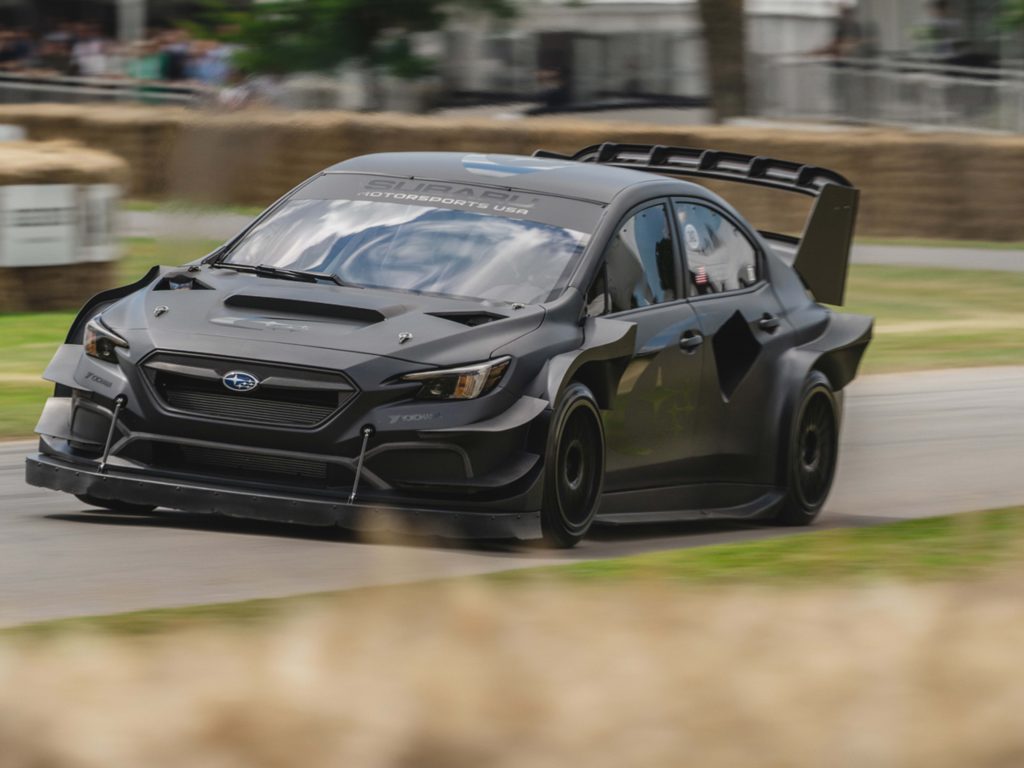
In 2024, the Goodwood Festival of Speed welcomed a new competitor that quickly attracted attention for its aggressive looks, thunderous sound, and explosive performance: the Subaru WRX “Project Midnight,” developed by the Vermont SportsCar team. Much more than a modified rally car, Project Midnight was built with a single goal: to be the most radical WRX ever created. Based on the WRX ARA24, the body was completely redesigned in carbon fiber, the center of gravity was lowered as much as possible, and the curb weight was around 1,100 kg.
Under the hood, a 2.0-liter turbocharged boxer engine producing over 670 hp connected to a competition-grade all-wheel drive system. Was Travis Pastrana at the wheel? Not this time. The mission fell to British driver Scott Speed, an experienced driver with experience in Formula 1 and the X Games, and known for his precise and aggressive driving.
During Sunday’s shootout, Speed launched fiercely and kept the car glued to the ground through every corner of Goodwood’s narrow hillclimb. With a time of 46s07, the WRX Project Midnight finished among the fastest cars in the event, proving that the combination of extreme engineering, a combustion engine, and a dash of madness still has plenty of room in a world increasingly dominated by electric cars.
23. Jonathan Palmer – Williams FW08B Cosworth (1995) – 46s06
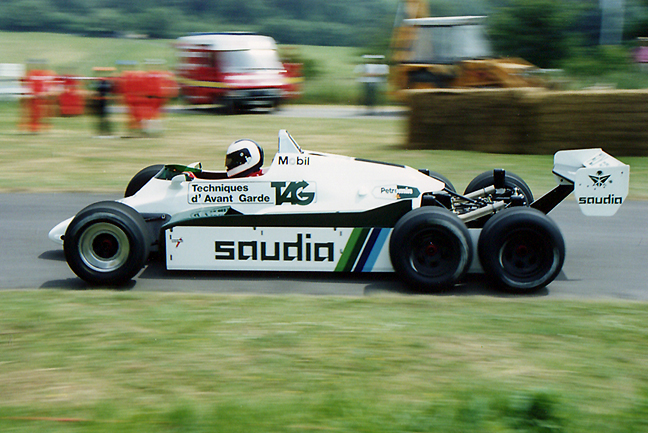
The last attempt at a six-wheeled Formula 1 car, the FW08B, was developed in 1982 based on the victorious FW07, aiming to improve traction at a time when teams were beginning to migrate to turbocharged engines. According to some sources, the car performed excellently, and English driver Jonathan Palmer stated that it was impossible to tell the car had two sets of rear wheels based on its track behavior. However, the FIA expressly banned six-wheeled cars from 1983 onwards, and the project was abandoned. Palmer himself would return to drive the car in 1995, achieving victory with a time of 46.06 seconds, then the track record.
22. Rod Millen – Toyota Celica “Pikes Peak” (2015) – 45s88
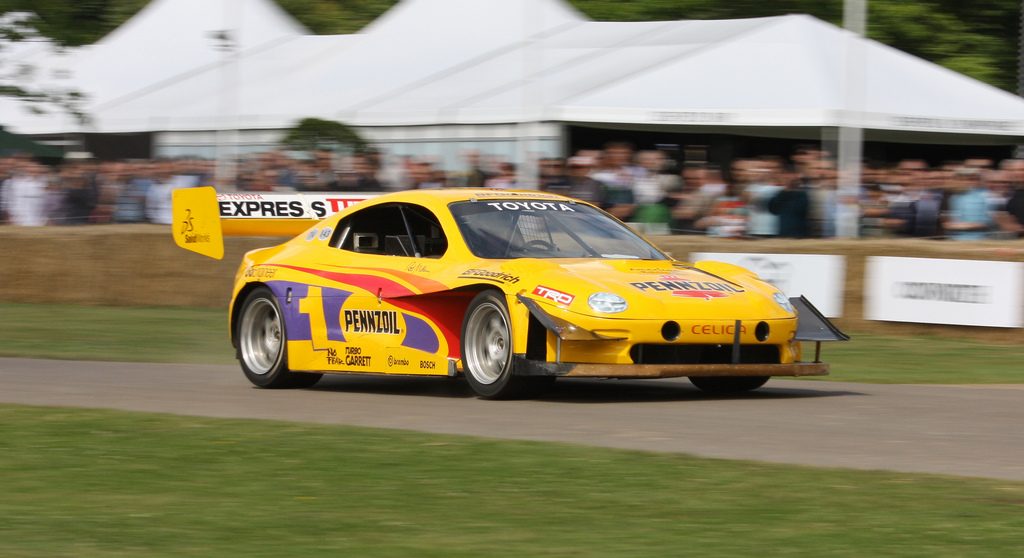
Built with a tubular frame, carbon fiber body, and equipped with a 2.1-liter, approximately 850-horsepower engine used in Toyota’s IMSA GTP cars (the North American version of Group C), the Celica Pikes Peak Special was driven by Rod Millen at Pikes Peak in 1994, breaking the track record by approximately 40 seconds and setting the record for the completely unpaved track. This record was so absolute that it was only broken 13 years later by Japanese driver Nobuhiro Tajima, at a time when the track was already partially paved. Twenty-one years after his historic victory, the American returned to racing his car, setting the third fastest time and reaching the podium in 2015.
21. Michael Bartels – Maserati MC12 “Goodwood Cent 100” (2014) – 45s82
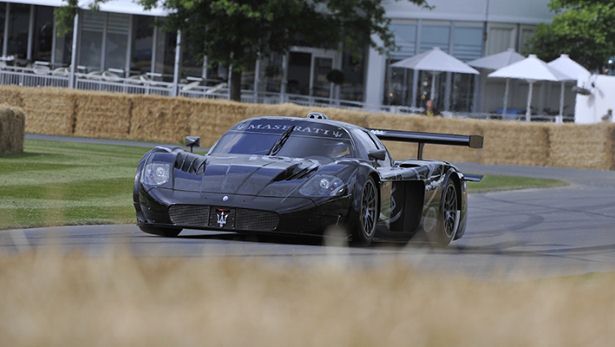
Developed for Maserati’s return to the FIA GT1 championship using the Ferrari Enzo chassis, the MC12 also represented the resurrection of the homologation specials that reigned at Le Mans in the second half of the 1990s. Although it was not allowed to enter the French race, the car dominated the FIA GT1 championship, securing the constructors’ championship for Maserati in 2005 and 2007, and only teams using the car were champions between 2005 and 2010. For the brand’s centenary in 2014, a spare chassis was used to create the MC12 “Goodwood Cent 100”, which received a paint job commemorating the brand’s victories on the track. No longer requiring the restrictors specified by the GT1 regulations, the Maserati team reworked the engine to achieve an output of 766 hp. In the hands of former factory driver Michael Bartels, the MC12 claimed second place, losing only to Sebastian Loeb’s monstrous Peugeot 208 T16.
20. Justin Law – Jaguar XJR12D (2022) – 45s81
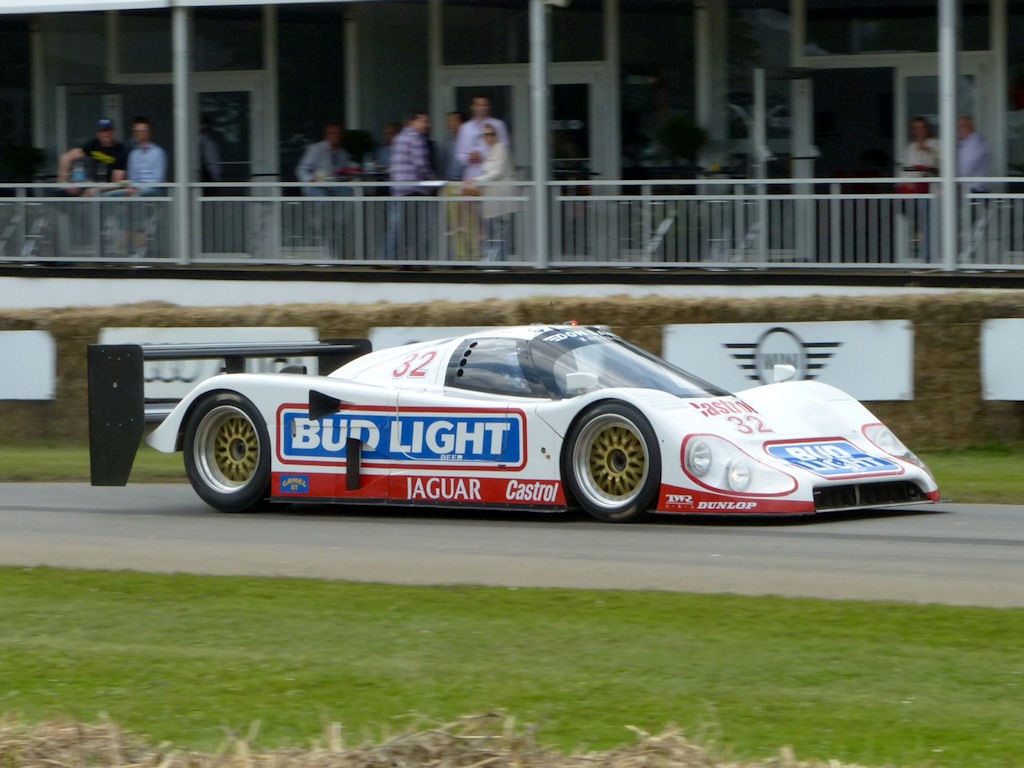
The Jaguar XJR-12 was the TWR/Jaguar model developed for the 1990 season, with victories at the 24 Hours of Daytona and Le Mans. In 1991, the model became ineligible for the World Sportscar Championship (due to a regulation change that forced the use of 3.5-liter engines similar to those used in F1 at the time), but continued to compete in the United States in IMSA races, albeit without achieving major victories. The model in question is one of the last built, and was the winner of the 2017 shootout driven by Justin Law, but set its best time in the 2022 shootout, with a time of 45.81.
19. Ben Mitchell – March-BMW 782 (2022) – 45s64
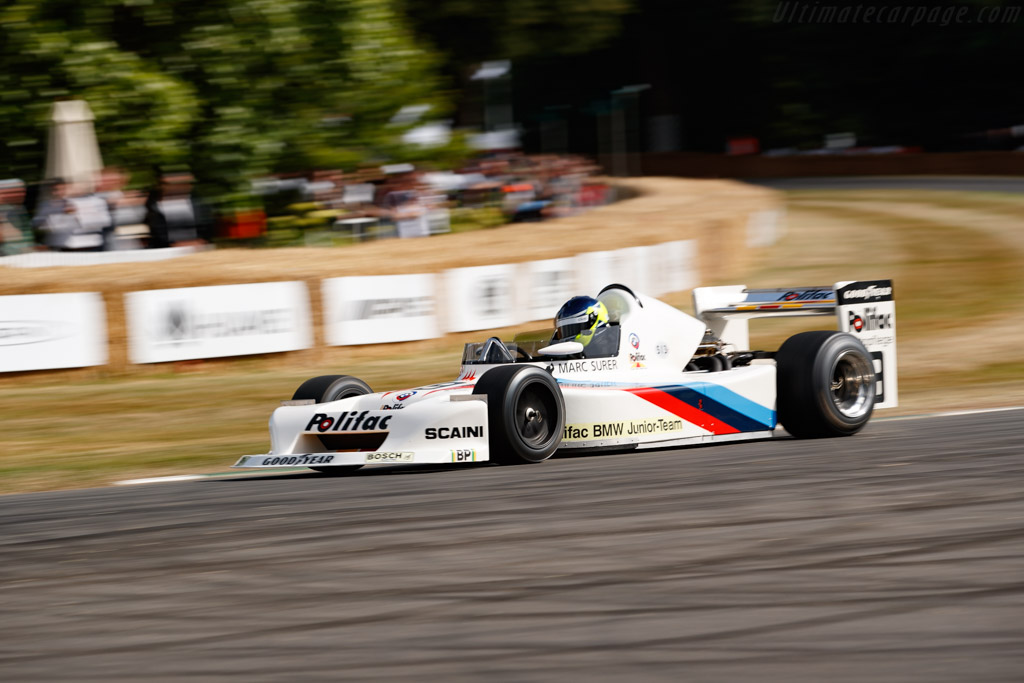
Developed in 1978, the March 782 is a Formula 2 single-seater that dominated its debut season with 11 wins in 12 races, and remained competitive until 1980. During the 2022 shootout, Ben Mitchell masterfully drove the little March to a time of 45.64 seconds, better than many F1 single-seaters of the same era.
18. Jean-Phillippe Dayraut – Midjet Mini Pikes Peak (2015) – 45s51
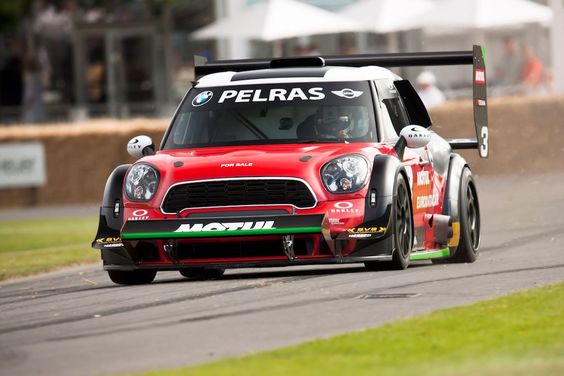
Another machine that competed at Pikes Peak, the Frenchman’s car only looks like a Mini. With a tubular frame and carbon fiber body, the car is equipped with a mid-mounted engine taken from a GT-R and tuned to produce around 900 hp, which, combined with its low weight of 950 kg, makes it a small rocket on the track. In 2015, the driver tried his luck at the English event, losing only to Olly Clark’s equally monstrous Impreza “Gobstopper II.”
17. Richard Lietz – Porsche 718 GT4 ePerformance (2022) – 45s50
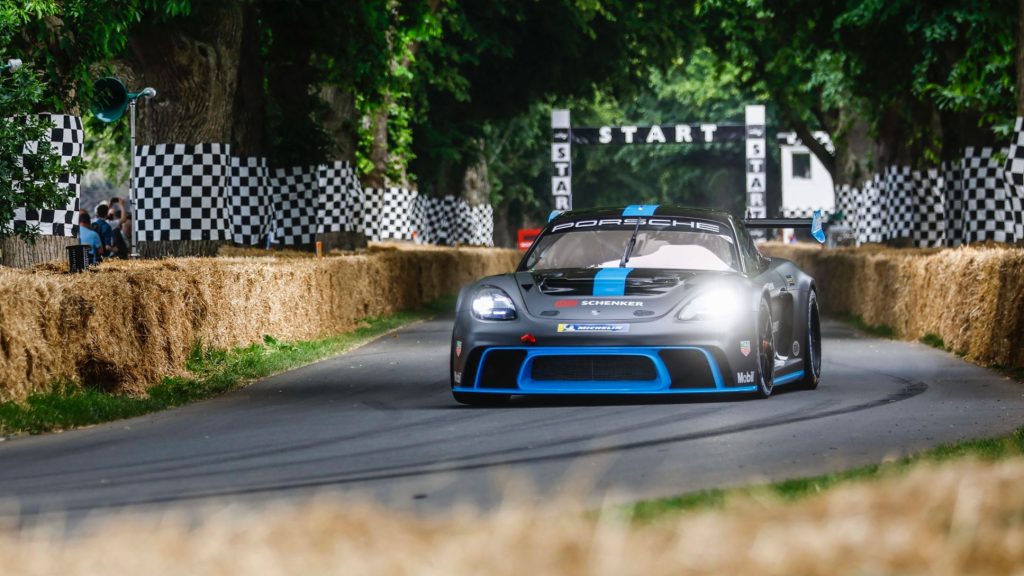
In one of the fastest shootouts, driver Richard Lietz took the Porsche 718 GT4 ePerformance to second place, trailing only the impressive McMurtry Automotive Speirling. Built with a silhouette mimicking the conventional 718 Cayman, the GT4 ePerformance has a natural fiber body and uses two electric motors (one on each axle), reaching an impressive 1,073 hp in qualifying mode.
16. Marvin Kirchhöfer – McLaren Solus GT (2023) – 45s35
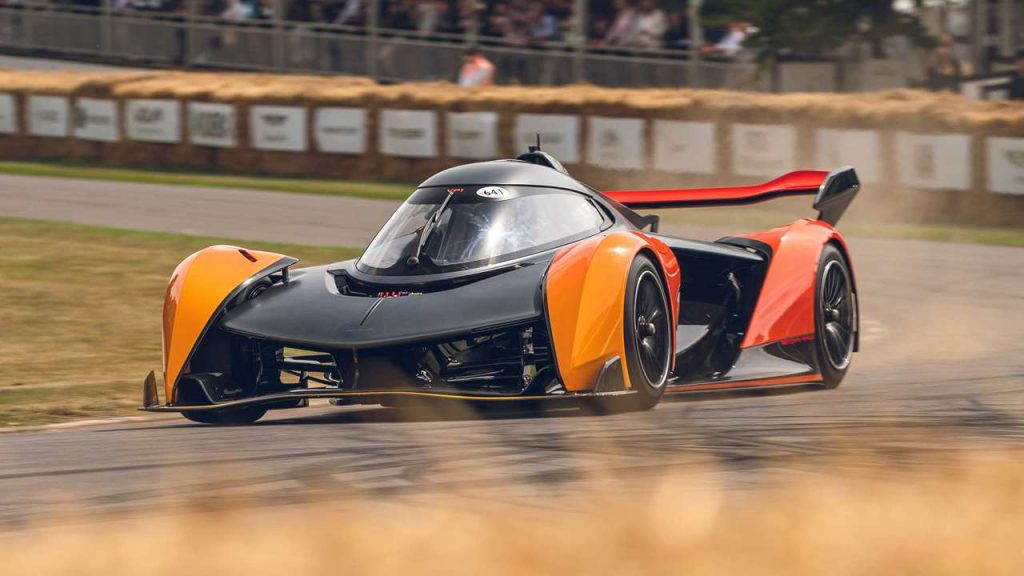
In the hands of McLaren factory driver Marvin Kirchhöfer, the Solus GT completed the 1.86km hill climb at Goodwood in a blistering time of 45.34 seconds, beating its nearest rival by a full second during the 2023 shootout. Powered by an 840bhp 5.2-litre Judd GV5 V10 engine, the Solus is a track-only car with a design inspired by the McLaren Ultimate Vision Gran Turismo, a concept car developed for the Gran Turismo franchise.
15. Martin Strelton – Tyrrell P34B Cosworth (2000) – 45s05
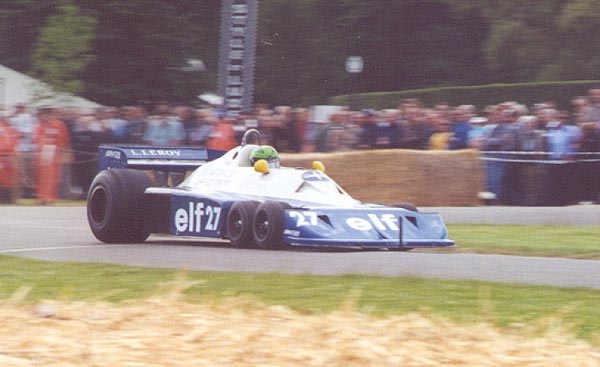
At a time when practically all teams used the same engine (the Cosworth DFV), Tyrrell designer Derek Gardner saw that the only way to gain speed against rivals would be to reduce aerodynamic drag. Realizing that much of this drag came from the interaction of the front wheels with the air, he created the P34 concept, replacing the two conventional front wheels with four small 10-inch wheels. The only six-wheeled car to compete in F1, the P34 debuted in 1976 and led Tyrrell to third place in the constructors’ championship, behind only Ferrari and McLaren. For 1978, the model was updated to its B specification, but Goodyear’s lack of interest in developing the small front tires resulted in a drop in performance. Since the turn of the millennium, the car has enjoyed great success in historic F1 races after manufacturer Avon developed suitable front tires for the model. One of those who drove the P34 during this period was Englishman Martin Strelton, who in 2000 drove his P34B to victory in the shootout.
14. Rob Bell – McLaren 720S GT3X (2021) – 45s01
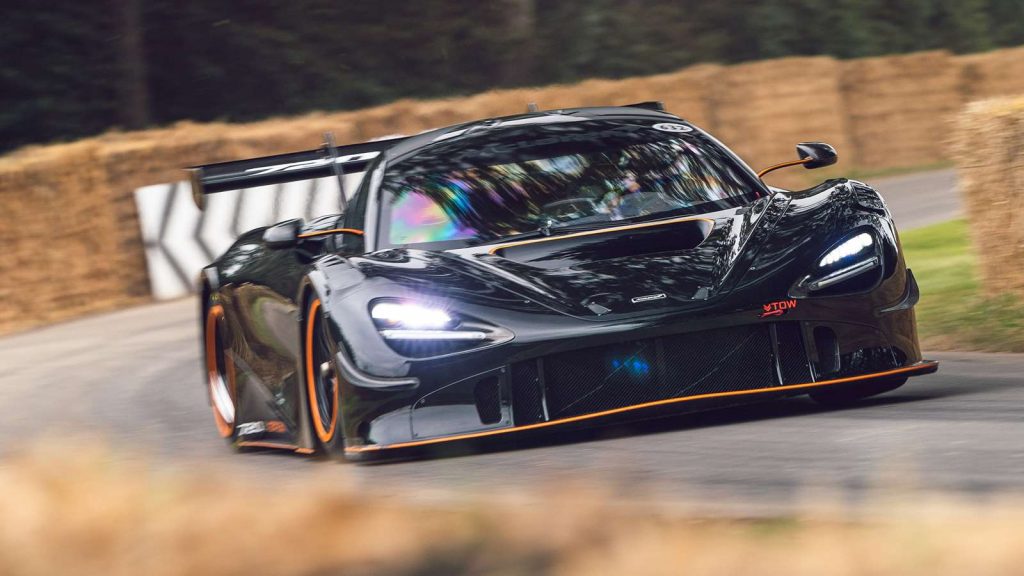
Developed by McLaren as a “no-limits” version of the 720S GT3, the GT3X features a massive power increase over the road-legal GT3, with the same 720 hp as the road-going version and the option of a push-to-pass button that boosts that figure by an additional 30 hp, maximizing the GT3 car’s chassis and aerodynamic performance. Driven by Rob Bell, the GT3X won the 2021 Shootout and currently holds the title of fastest GT car at Goodwood.
13. Jonathan Palmer – Williams FW07B Cosworth (1996) – 45s00

The first Williams car to exploit ground effect, the FW07 was designed by Patrick Head using the same principles introduced by Colin Chapman in the Lotus 78. Finishing runner-up for Williams in 1979, the model was updated for the 1980 season, receiving the designation FW07B. The aerodynamic evolution was so significant during this period that the front wings could be completely eliminated, and the duo Alan Jones and Carlos Reutemann secured Williams’ first constructors’ title. The car was revised again to comply with the 1981 regulations, with the elimination of the movable skirts, and remained dominant, securing another title for the English manufacturer. At the 1996 Festival of Speed, Englishman Jonathan Palmer drove the car to victory, setting a new track record.
12. Olly Clark – Subaru Impreza “Gobstopper II” (2015) – 44s91
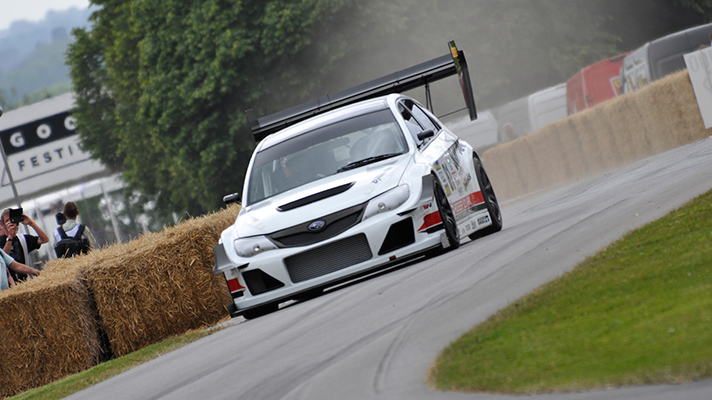
Held in several countries, Time Attack-type championships, where participants compete against each other for the fastest lap, have become increasingly common. In the British championship, the fastest category is the Pro Class, which allows virtually any modification. Englishman Olly Clark prepared an incredible machine for this category, starting with a tubular frame and a body based on the Impreza Hatch WRC, but with a carbon fiber roof, hood, and fenders. The aerodynamics were developed in the MIRA wind tunnel, with front and rear wings capable of making a Pikes Peak car jealous. The engine was developed from a standard Subaru EJ20 engine, but with power in the region of 900 hp, combined with a Zytek sequential transmission. Since then, the car has dominated its category in England, and Olly Clark also won the Goodwood shootout in 2015 and 2016.
11. Gary Ward – Leyton House CG901B Judd (2009) – 44s64
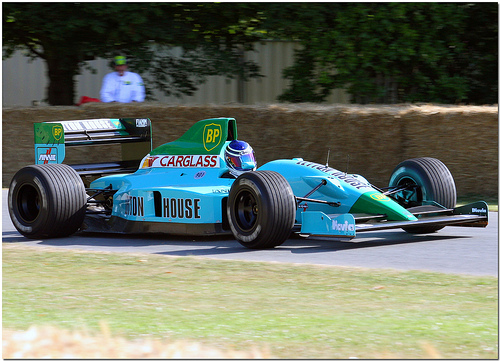
The first Adrian Newey-designed car to appear on this list, the CG901 was developed to utilize the Judd EV 3.5 V8 engine. After a disappointing start to the season, a B variant was introduced mid-season to correct design flaws induced by faulty data from the team’s wind tunnel. The B configuration performed much better, often outperforming cars from better-funded teams, with its best result being second place for Italian Ivan Capelli at the French Grand Prix. This strong performance secured the team seventh place in the constructors’ championship that year, and a significant amount of extra money. In 2012, Englishman Gary Ward drove one of these models in the shootout, only to be beaten by Justin Law’s Jaguar XJR8/9.
10. Sebastien Loeb – Peugeot 208 T16 Pikes Peak (2015) – 44s60

After abandoning the 24 Hours of Le Mans, Peugeot was left without a global motorsport program. With a tight budget, the French team assembled a mini-Frankenstein to compete in the 2013 Pikes Peak International Hill Climb: a tubular frame was fitted with a carbon fiber body reminiscent of the recently launched 208, and features such as the suspension, brakes, and even the rear wing were borrowed from the 908 HDi of Le Mans, while the engine, a 3.2-liter twin-turbo V6 unit from the Pescarolo prototype, which, without the restrictions, produces 875 hp. With this package and experienced rally driver Sebastian Loeb at the wheel, the French team won in Colorado, setting a record of 8:13.878, which was only broken by Romain Dumas’ Volkswagen IDR, in a much more expensive effort. In 2013, the car was also entered for Goodwood, this time driven by Gregory Guilvert, who only managed second place. In 2014, Loeb reunited with the 208 at Goodwood, and many expected the official track record to be broken. Despite winning outright, Loeb’s time was still 3 seconds off the record, and was only good enough for fifth place all-time.
9. Anthony Reid – Williams FW07B Cosworth (2008) – 44s58
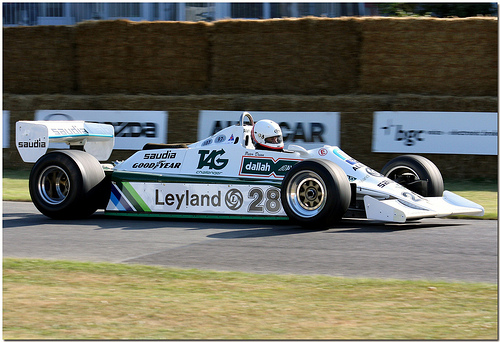
In 2008, Englishman Anthony Reid conquered Goodwood in the Williams FW07B, the same car that in 1996 had been driven to victory by Jonathan Palmer, and set the fastest time for a classic Formula 1 car on the track.
8. Justin Law – Jaguar XJR8/9 (2009) – 44s40
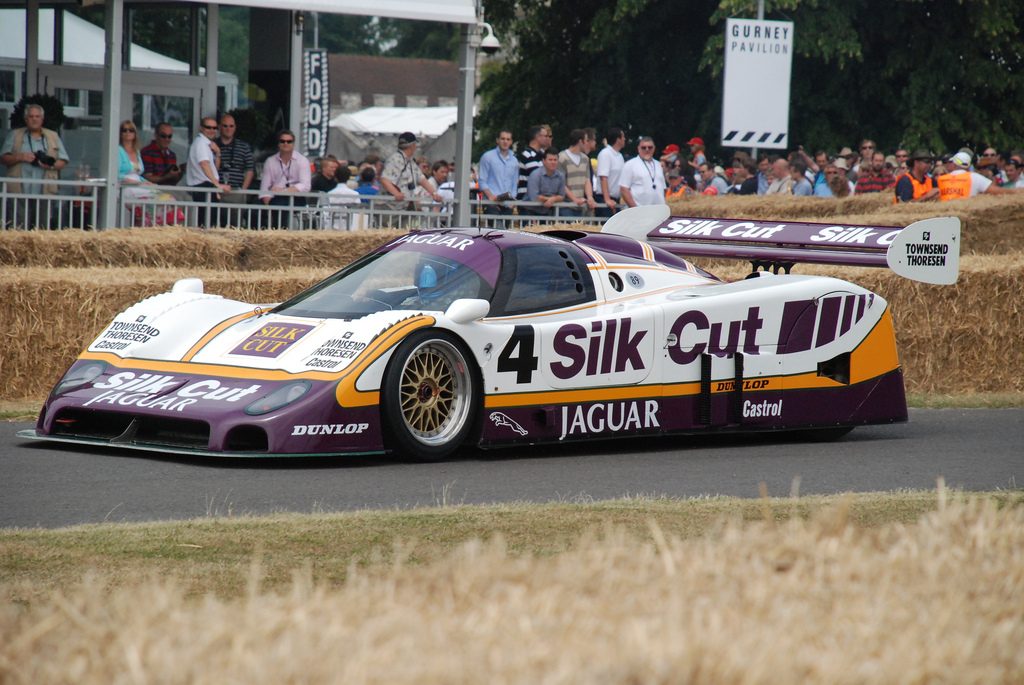
Created as an evolution of the Jaguar XJR6 that had competed in 1986, the XJR8 was launched in 1987 to compete in the World Endurance Championship. Equipped with a 7-liter V12 engine derived from the one used in the Jaguar XJS, the JR8 dominated the 1987 season, winning 8 of the 10 races and securing the drivers’ and constructors’ titles for Jaguar. However, maximum glory at Le Mans eluded Jaguar, and for 1988 the model was revised and became the XJR9, which went on to win the 24 Hours of Daytona, the 24 Hours of Le Mans, and the 1988 World Endurance Championship. The model continued to compete in 1989, but was already outdated and unable to secure victories that season. In addition to its racing history, the model served as the basis for Jaguar’s first supercar, the XJR-15, launched in 1990. British driver Justin Law went on to use the model to compete in the Goodwood Festival of Speed, winning in 2003, 2008, 2009 and 2012. In 2009, Law had the race of his life to achieve a time of 44.40 seconds and victory in one of the tightest shootouts in history.
7.Peter Dumbreck – Nio EP9 (2018) – 44s32
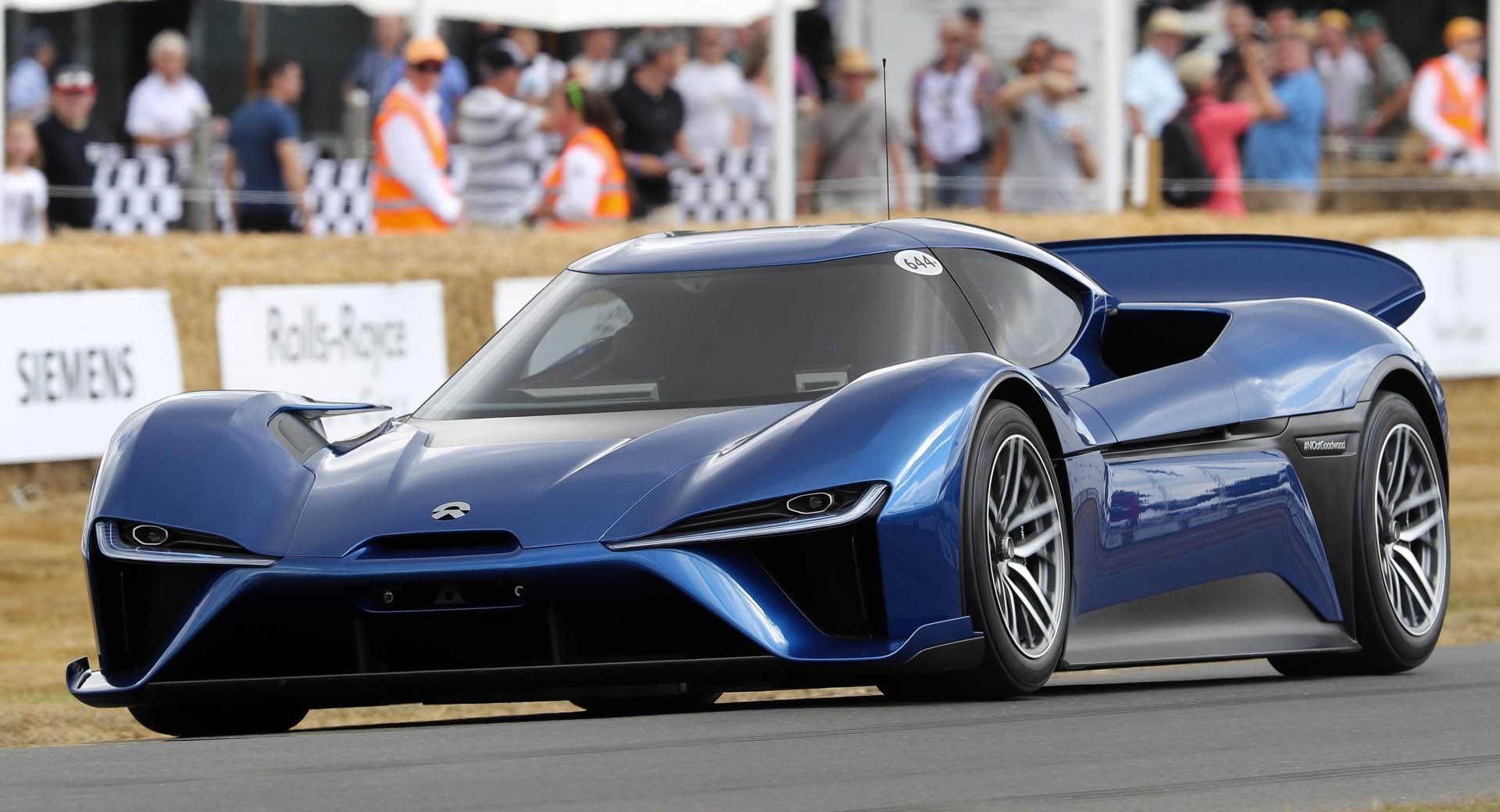
The NIO EP9 is the first creation of NIO, the electric car brand of Chinese company NextEV. The result of an 18-month development process utilizing the expertise of NIO’s Formula E team, the EP9 features a carbon fiber monocoque chassis, built to LMP1 specifications. It also features an electric motor in each wheel, totaling 1,360. This layout allowed for the implementation of an advanced torque vectoring system, through precise control of each motor. As if that weren’t enough, the EP9 features an active suspension system and a rear wing with three settings: parked, low drag, and high drag, capable of generating up to 2,447 kg of downforce at 240 km/h. Since then, the model has been collecting records on several tracks, including the Nürburgring record for electric vehicles. In 2018, it finished second in a tight shootout, losing by less than half a second to the Volkswagen I.D. R Pikes Peak by Romain Dumas.
6. Romain Dumas – Ford SuperVan 4.2 (2024) – 43s98
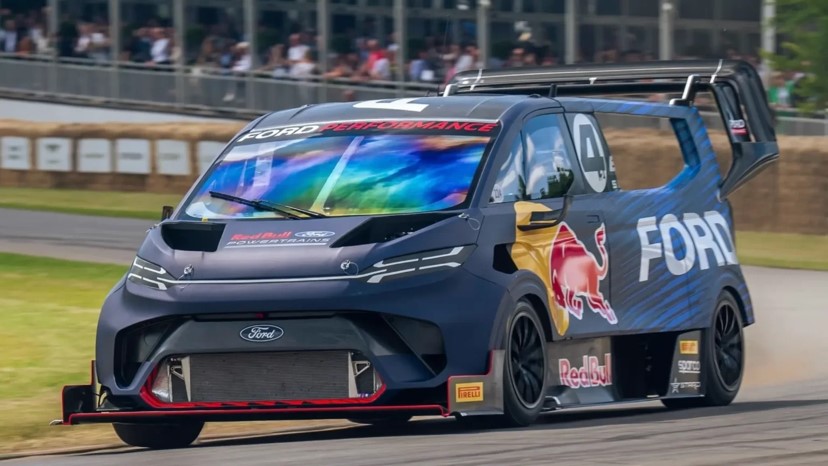
In 2024, Ford once again surprised the Goodwood Festival of Speed crowd by fielding the SuperVan 4.2 in the traditional hill climb shootout. It was a radical reinterpretation of the iconic Transit delivery van, equipped with an all-electric powertrain developed by Ford Performance in partnership with STARD. The SuperVan 4.2 was a direct evolution of the 4.0—lighter, with new active aerodynamics and three electric motors delivering over 1,400 horsepower to all four wheels.
To drive this monster, the brand once again called on Frenchman Romain Dumas, an experienced hill climb driver known for his Pikes Peak records and his Goodwood victories in 2018 and 2019 with the Volkswagen ID.R. Despite the van’s unconventional dimensions, its performance was worthy of a Le Mans prototype. On his run on the British track, Dumas delivered a clean and aggressive climb, setting the fastest time of the weekend: 43.98 seconds.
5. Romain Dumas – Volkswagen I.D. R Pikes Peak (2018) – 43s86
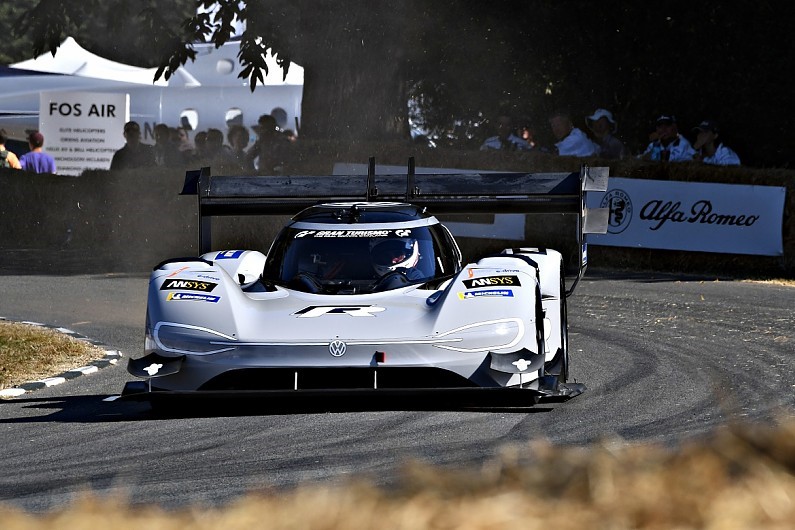
In 2017, the Volkswagen Group’s reputation was tarnished by Dieselgate, an emissions scandal that revealed that several of the group’s diesel-powered vehicles used calibration strategies capable of falsifying homologation test results. As a result, the German company decided to change its approach to vehicle development, presenting an aggressive plan to hybridize and electrify its vehicle lineup, resulting in the I.D. line of pure electric vehicles. To promote this new initiative, one of the chosen avenues was to invest in motorsports, and today, the only competition where electric cars can compete with internal combustion engine-powered vehicles is hillclimbing. The car was completed in 250 days, consisting of a carbon fiber monocoque with wind tunnel-developed aerodynamics, powered by two electric motors (one on each axle), producing a total power of 680 hp, with a modest curb weight of 1,100 kg. In 2018, the car driven by Romain Dumas broke Sebastian Loeb’s Pikes Peak record by more than 16 seconds, and three weeks later the car was in Europe to compete in the Goodwood event. The expectation was that Nick Heidfeld’s all-time record would be broken, as the French driver had achieved a time of 43.05 seconds in practice. However, on shootout day, that time was not repeated, but Dumas was still crowned the winner of the 2018 event.
4. Graeme Wright Jr – Gould GR51 Cosworth (2003) – 42s90
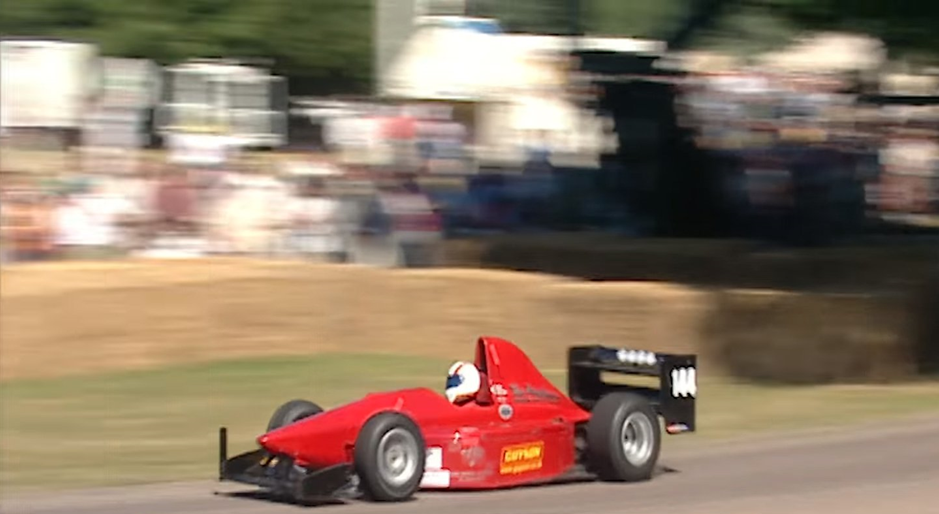
Based on the carbon fiber chassis of a Ralt F3 fully customized for hillclimb events, the GR51 dominated the 2001 and 2002 British Championship seasons, securing the title in both years for Scotsman Graeme Wright Jr. Equipped with an Opel-Cosworth DTM engine whose displacement was increased from 2.5 liters to 2.8 liters and an Arrows F1 transmission, Wright Jr. took the car to an outright victory in the 2003 shootout, and secured his position as the second fastest on the track.
3. Romain Dumas – Volkswagen I.D. R Goodwood Spec (2019) – 42s32
After winning Pikes Peak and Goodwood in 2018, Volkswagen reworked its ID.R prototype with several aerodynamic upgrades, including a DRS system to break the Nürburgring record for electric vehicles. The prototype was then specifically prepared for Goodwood, with a calibration of the energy management system allowing full use of the electric motors and the smallest possible battery pack for the car, resulting in a weight of under 1,000 kg including the driver, a reduction of almost 100 kg compared to the car that competed at Pikes Peak. Nick Heidfeld’s record was expected to be broken, and Romain Dumas even clocked a time of 39.90 seconds in the practice sessions (an unofficial track record). However, rain on the Sunday of the shootout considerably worsened the track conditions, and the official time set by the VW car was “only” 42.32 seconds.
2. Nick Heidfeld – McLaren MP4/13 Mercedes-Benz (1999) – 41s60
The first car created by Adrian Newey for McLaren (and second to appear on this list), the MP4/13 was the car to beat in the 1998 F1 season. In a year where regulation changes introduced narrower cars and the infamous grooved tires, the car secured the constructors’ championship for McLaren and the drivers’ championship for Finn Mika Häkkinen. In 1999, German Nick Heidfeld, then McLaren’s test driver, positioned his car on the starting line for what would be one of his finest performances. Driving at the limit in every corner, he crossed the finish line with a time of 41.60 seconds, an 8-second lead over his competitors, which drew a round of applause from the crowd. This race, however, was considered too risky for a narrow track without proper run-off areas, with McLaren itself admitting it should not have sanctioned the race. Because of this, the timing of modern Formula 1 cars was also banned, and the record stood for an incredible 23 years!
1. Max Chilton – McMurtry Automotive Speirling (2022) – 39s08
Após 23 anos, finalmente o recorde do traçado de Goodwood caiu em 2022, com uma impressionante pilotagem do britânico Max Chilton à bordo do McMurty SpéirlingAfter 23 years, the Goodwood track record finally fell in 2022, with a stunning performance by British driver Max Chilton aboard the McMurty Spéirling, a small electric prototype weighing 1,200 kg and producing an impressive 1,000 hp from two electric motors positioned on the rear axle. In addition to its excellent power-to-weight ratio, the Spéirling boasts active aerodynamics, using the same solution as Can-Am’s Chaparral 2J, in the form of two fans capable of generating up to 2,000 kg of downforce, resulting in over 3 g of lateral acceleration and a 0-100 km/h time of 1.55 seconds., um pequeno protótipo elétrico com 1.200 kg e impressionantes 1.000 HP de dois motores elétricos, posicionados no eixo traseiro. Além da excelente relação peso-potência, o Spéirling tem como trunfo o uso de aerodinâmica ativa utilizando a mesma solução do Chaparral 2J de Can-Am. na forma de dois ventiladores capazes de gerar até 2.000 kg de downforce, resultando em mais de 3g de aceleração lateral e um 0-100km/h em 1,55 segundos.

